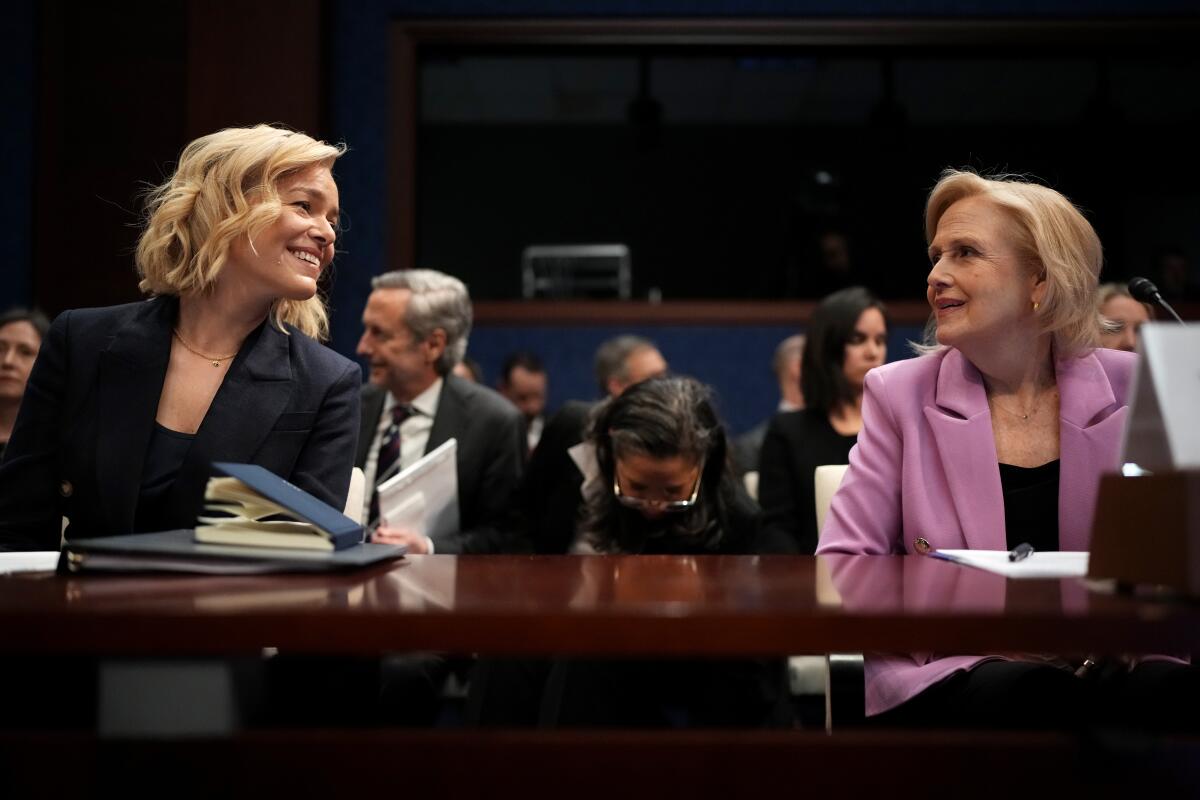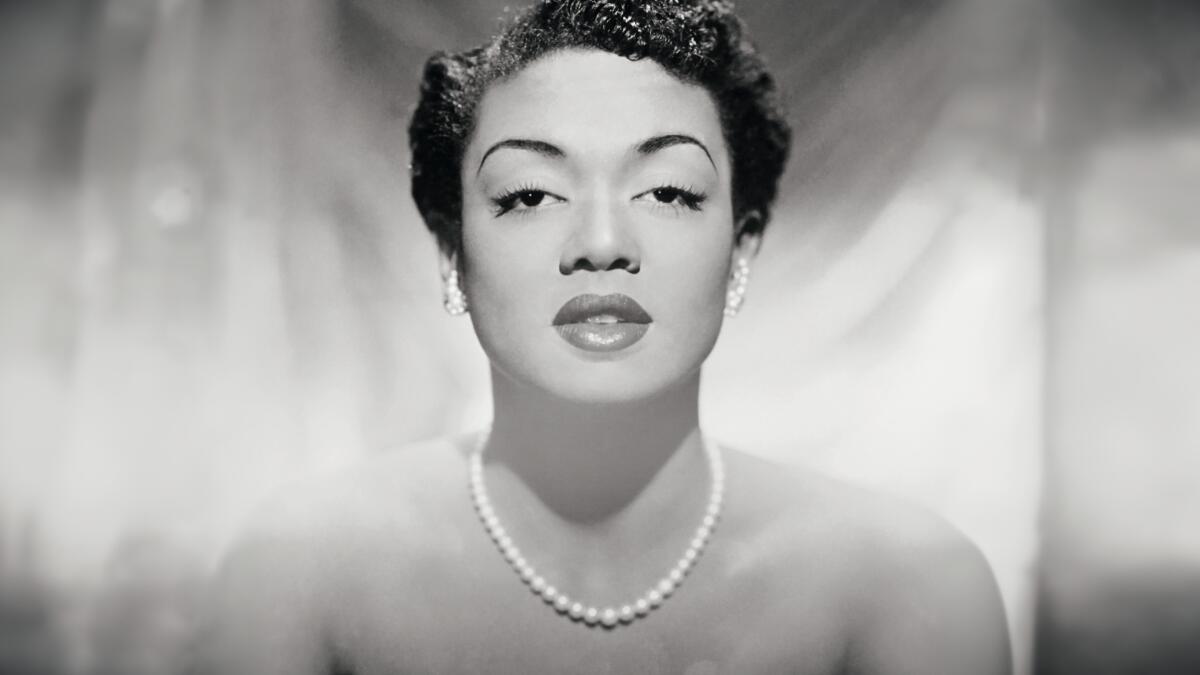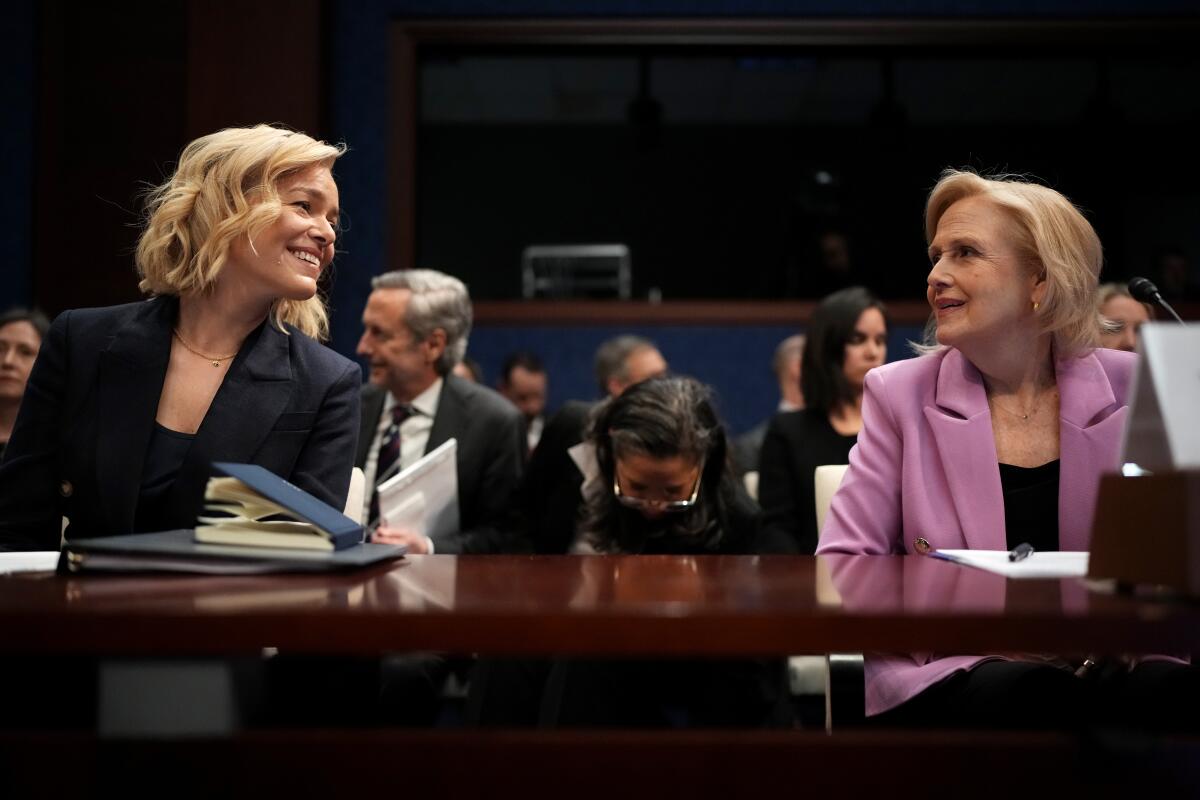Every so often across my 21 years as a TV critic at this paper, I have been moved to defend public broadcasting against regular right-wing attempts to defund it. The difference now — well, one difference — is we are living in a time without guardrails, when the ethos at the top seems to be Do What You Want, Lie Outrageously and Trust That You’ll Get Away With It, when all sorts of hard-won, long-established public goods are being crippled by executive caveat and formerly more-or-less independent institutions scramble to paint the roses red in order to keep their heads.
On Wednesday, PBS Chief Executive Paula Kerger, and Katherine Maher, who heads NPR, testified before Congress, essentially to bat off charges of liberal bias and to make the case that public broadcasting is a valuable social good, to politicians who don’t necessarily value social goods.
It is tragicomical that this hearing — under the name “Anti-American Airwaves: Holding the Heads of NPR and PBS Accountable,” if you need any better indication of a mind already made up — was being led by Georgia Republican Rep. Marjorie Taylor Greene, who called PBS and NPR “radical left-wing echo chambers” for what she whimsically imagines to be “a narrow audience of mostly wealthy, white, urban liberals and progressives who generally look down on and judge rural America.” As an inveterate espouser of lunatic conspiracy theories, Greene — who has regularly accused Democratic politicians of murder, pedophilia and satanism and characterizes public media as “communist” — might fairly be said to occupy a radical right-wing echo chamber. If you live in a fantasy world, facts are always going to seem a little crazy.

Katherine Maher, left, and Paula Kerger had to bat off charges of liberal bias and make the case that NPR and PBS are valuable social goods.
(Andrew Harnik / Getty Images)
Like every news and/or entertainment platform, public broadcasting, competing for attention in a crowded marketplace, has had to navigate a changing world. When Congress passed the Public Broadcasting Act of 1967, much of the country was underserved by television, even where TV was abundant — in Los Angeles, there were three major networks and four local stations, plus a few sometimes fuzzy UHF channels. Public broadcasting was a unique, genuine alternative to commercial television, extending the medium’s reach and enriching its content; it was not a business, it had a mission, and government support made it possible. President Lyndon Johnson, who signed the act into law, declared, “It announces to the world that our nation wants more than just material wealth. … While we work every day to produce new goods and to create new wealth, we want most of all to enrich man’s spirit.”
Opponents, including the current FCC chair Brendan Carr, argue that in the new media landscape, with its Cheesecake Factory menu of choices, there is no reason for public media to exist and certainly no reason for the government to give it any money — an idea to which it is already indisposed. (Carr’s calling for an investigation into corporate sponsorship — questioning whether the brief filmed spots before a show constitute forbidden commercials — strikes me as meant to cut another leg from table.) Such claims reflect a misinformed, incurious reading of how public broadcasting works, what it does and whom it serves.
For one thing, it is free; if you want to get technical and say tax dollars fund it, it is, for the consumer, as good as free — an estimated $1.50 per American per year. The appropriation for the Corp. for Public Broadcasting ($535 million for fiscal 2025), which funnels funds to some 1,216 independently operated public radio stations and 365 public television stations, accounts for less than a hundredth of a percent of the federal budget. These grants make up a minor slice of a station’s operating expenses (an average of 8% for radio and 17% for television), which also depend on audience contributions, foundation grants, trusts and corporate underwriting; yet in less affluent, more remote areas, which the CPB was formed in part expressly to serve, they might be all that keeps the lights on.

Documentary filmmaker Ken Burns has been a mainstay of PBS, which has helped fund his documentaries on subjects like the Civil War, baseball and the American buffalo.
(Mark Sommerfeld / For The Times)
Notwithstanding YouTube stars who create smartphone videos that may earn a million views online, it takes money to produce quality television — to really report the news, to pay for research, travel, photo rights and studio time, to hire people with talent and experience — and, for that matter, to acquire your next favorite British mystery or Jane Austen adaptation. You’re not going to find a series by Ken Burns, the country’s most famous documentary filmmaker, or a film by Frederick Wiseman, its greatest living documentarian, just dropping on YouTube — unless PBS posts it there. Public television, with which both directors have long histories, has made their work possible and available.
And there is more to public broadcasting than PBS and NPR, as much as they might seem to be synonymous, and more to PBS and NPR than their news programs — PBS, for the record, does not produce programs but only distributes programs produced by member stations — though that is where Greene and company primarily aimed their “liberal bias” attack. (For what it’s worth, I know more than a few people on the left who find NPR’s news coverage exasperating.)
Stations may subscribe to PBS and NPR — or not — or look to a combination of other sources for programming, including American Public Television; the Independent Television Service, home to the fine documentary series “Independent Lens”; the Public Radio Exchange (PRX), which produces “Left, Right and Center,” “This American Life” and “The Moth”; and American Public Media, creator of “Marketplace” and “The Splendid Table.” Many create their own shows — KCET’s fine “Artbound,” “SoCal Connected” and “Lost L.A.,” LAist’s “Airtalk With Larry Mantle” and KCRW’s “Press Play With Madeline Brand,” to name but a few local examples.
But I doubt Greene or her like-minded colleagues have spent much, or any time, watching PBS or listening to NPR, beyond the minimum needed to fuel their outrage. The fact that the system is decentralized means that its audience is neither urban nor rural, white nor BIPOC, rich nor poor, coastal nor heartland — it’s all those things, reflecting, and participating in, the community where each station is based, giving each an individual character. It’s the very opposite of elite and all in all presents a more complete picture of the nation than you are liable to find elsewhere.
If you dip into the pbs.org website, where programs from across the country are available to stream, most for free — a tax-deductible donation of $5 a month gets you a “PBS Passport” that unlocks the rest — you will find “Michigan Out-of-Doors,” “Wyoming Chronicle,” “Kentucky Afield,” “Prairie Sportsman,” “Virginia Farming,” “Tennessee Crossroads,” the Indigenous “Native Report,” shows on woodworking, fishing, quilting and high school sports. I could go on and on making this point. To call public media radical because it makes room for ideas you might find objectionable is uninformed, delusional or mere performative partisan anti-wokeism.
Across 38 seasons, WNET’s “American Masters” has presented (among many others) films on a range of artists, writers and creators, including Patsy Cline, William F. Buckley, Truman Capote, Max Roach, Little Richard, James Baldwin, Laura Ingalls Wilder, Louisa May Alcott, Brenda Lee, Bob Hope, Hank Williams, Woody Guthrie, Charles Schulz, Margaret Mitchell, L. Frank Baum, Frederic Remington, Will Rogers, Alice Waters, Sister Rosetta Tharpe, Twyla Tharp, Loretta Lynn, Rita Moreno, Nam June Paik, Hazel Scott and Liza Minnelli. “American Experience” from WGBH includes among its library an 11-part documentary on the Vietnam War; multipart looks at presidents Theodore Roosevelt, Woodrow Wilson, Harry Truman, Ulysses S. Grant, John F. Kennedy, George H.W. Bush, George W. Bush and Jimmy Carter; the Nuremberg trials; the history of Las Vegas, of Mormons, of jeans, of the civil rights movement (the majestic “Eyes on the Prize”), World War I, the Civilian Conservation Corps, “God in America,” the Stonewall Uprising, the Wilmington Massacre, the Americans With Disabilities Act and whaling. WGBH’S “Nova” (its latest subversive episode is on weapons of the Revolutionary War) focuses on science and technology; WNET’S “Nature” looks at the world’s nonhuman inhabitants. (If, like Greene, you don’t believe in evolution but think hurricanes may be weaponized, you might have some difficulties here.)

“American Masters,” a series that presents documentaries on cultural and artistic figures, recently featured Hazel Scott, a pioneering Black entertainer, in “The Disappearance of Miss Scott.”
(Everett)
Obviously, NPR and PBS are not for everyone — I wouldn’t be writing this if they were — and not every show is for every supporter, whether it’s “Washington Week in Review” or “Antiques Roadshow.” (Well, “Antiques Roadshow” actually is for everybody.) But their focus is wide, not narrow, and twice as many Americans, according to a new report from the Pew Research Center, say government funding should continue versus those who say it should cease (43% are for it, compared with 24% against). Their news programs may be imperfect, as what is not, but they deal in fact-based reality and subscribe, ideally, to the old journalistic formulation of speaking truth to power — especially valuable in a time when power asserts that truth is whatever it says it is. (Witness, for example, the White House banning the Associated Press — “radical-left lunatics,” according to the president — from the press pool for refusing to call the Gulf of Mexico the Gulf of America.)
I suppose if Fox News is your yardstick of “fair and balanced,” the actually fair and balanced “PBS NewsHour,” from WETA in Washington, D.C., might seem unfair and unbalanced. But accusations that public media peddle disinformation and propaganda would be more accurately aimed at the accusers and at an administration seemingly dedicated to retailing a fairy-tale American history less offensive to MAGA sensibilities. NPR and PBS are old targets, but we’ve been lately hustled into a world in which the Smithsonian Institution is being examined for “improper ideology,” a phrase that smacks of Maoism, and an era of Orwellian inversions in which affirmative action becomes “reverse discrimination,” and any mention of difference is declared “divisive.” To be sure, if you’re offended by a cosmopolitan view of America, these venues are not for you.
Do I have a liberal bias? Well, I’m a liberal, so I suppose by definition I do. (Gulf of Mexico!) According to Merriam-Webster, liberalism is “a political philosophy based on belief in progress and stressing the essential goodness of the human race, freedom for the individual from arbitrary authority, and protection and promotion of political and civil liberties … especially: such a philosophy calling for the government to play a crucial role in relieving social inequities (such as those involving race, gender, or class) and in protecting the environment.” That seems a fine charter to me, and not a bad description of public media at its best. “At NPR,” reads a statement (still up) on its website, “diversity is not a program or initiative. It is an inextricable part of our mission to serve the American public.”
Make of it what you will.
